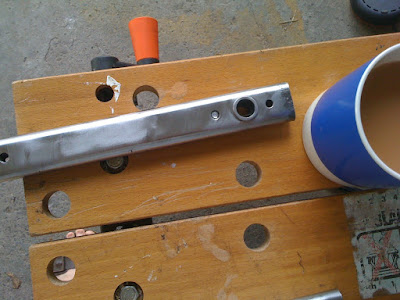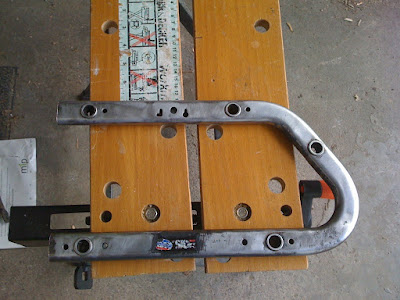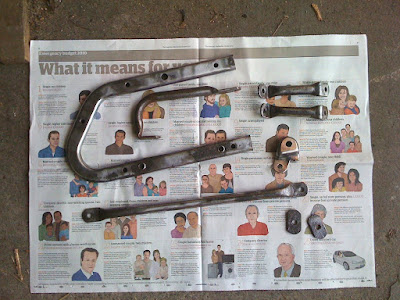I managed to get some quality time in today after a week of working and no tinkering.
I wasn't sure what I wanted to do so thought I'd remove the rear rack as the next candidate for stripping. This led to me removing the seat to get at the indicator wiring which was a festival of insulating tape and solder. Not at all how it looked in the Haynes manual.
The more I peel back the layers of the bike the more attention I think it could do with. It is a dilemma because I do not see this as a project, I want to be riding it, so there's no way I'm stripping it down to the frame but that is what it probably needs.
The upshot of all this internal debate was that I thought I'd better get a move on, so I decided to take the plunge into the spraying.
Having researched aerosol painting extensively I had a good game plan:
1) Shake paint well
2) Warm the piece being sprayed
3) Spray light coats and keep using the heat gun
4) er...repeat
I had already constructed a spray booth that I affectionately called Dr Caligari's Cabinet (it's an old horror film, I've never seen it but remember the title from somewhere). Here it is:
It involves an upended cabinet clamped onto a Workmate with a rock in a paint bucket for added stability. Screwed in the top is a battery powered motor for a glitterball that gently rotates the object being sprayed.
The next thing I had to do was prepare the pieces to be sprayed. I'd previously thought they were ready but having thought about the lumpy finish and how this would be a shame I tried giving it one last go with some super-coarse paper. (Essentially gravel stuck to paper). The result was gobsmacking. Here's the piece before sanding, with corrosion visible:
Following a hard sand, followed by a fine sand it looked like this:
Not perfect but an amazing improvement on an amazing improvement (see
here to see just how grim it was). The only downside was that my evening became an evening of sanding. Again.
After the fine sanding (using flexible sanding pads I picked up ages ago, which were very handy) I gave the piece a wipe over with white spirit and hung it to dry. I was thus ready to spray.
Only then did I read the instructions on the can. No huge surprises but Hammerite needs 3-4 coats with 15 min intervals so I built a makeshift drying rack held by my bicycle workstand to form a production line.
All set and the first piece went in. Motor on, air gun on (about 65% power - I have a posh DeWalt hot air gun with heat control), let's spray. As I suspected I tried too hard to cover the piece and it formed a drip. What a novice.
You can just about see the drip. What black there is is looking good, though.
I realised then that I was breaking my own cardinal rule of BE PATIENT. I calmed down and moved the piece to the drying rack. Then I dropped it. That'll teach me.
I proceeded to put a thin coat on most of the other pieces. Some were better than others. The drying rack was a great idea. Here are the results at the end of this evening. It's not brilliantly clear, I'll try again in the daylight.
Lessons learned today
1.) Be patient
2.) Preparation is everything
3.) Prepare the work environment too (I'll try warming the can as well)
4.) Clean the nozzle. It jammed up, so I used another and soaked the jammed one in white spirit. From now on I tip the can upside down and give it two good bursts after spraying.
5.) Spend longer heating the items. I think I was too hasty at first.
6.) Be patient
So a bit of sanding to rectify the drips and a few more coats tomorrow lunchtime I hope.

















